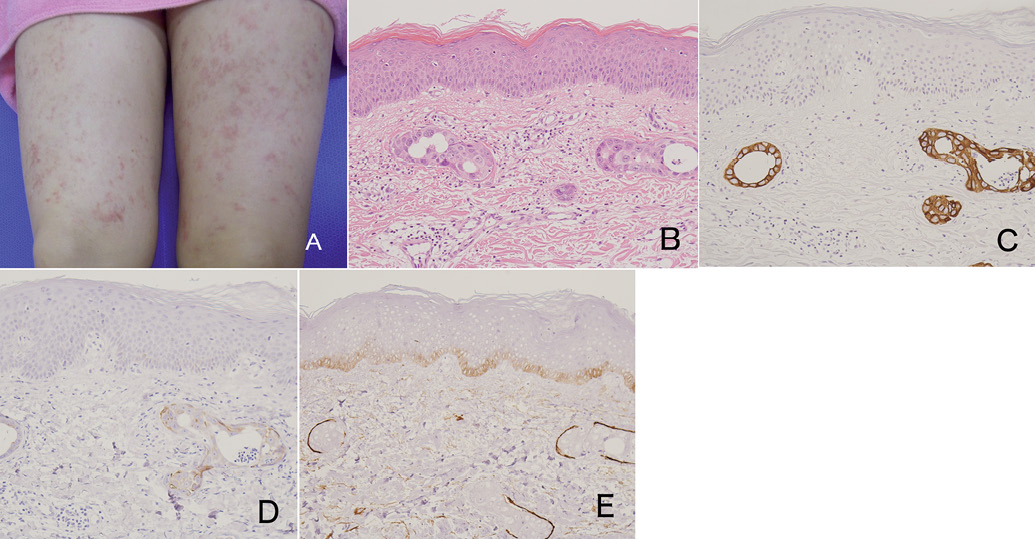Satoshi Nakamura1, Yoshio Hashimoto2, Kaoru Nishi2, Toshihiro Mizumoto2, Hidetoshi Takahashi3 and Hajime Iizuka3
Departments of Dermatology, 1Jichi Medical University Saitama Medical Center, Amanumacho1-847, Omiya-ku, Saitama, 330-8503 2Asahikawa Kousei Hospital, and 3Asahikawa Medical University, Hokkaido, Japan. E-mail namu@asahikawa-med.ac.jp
Accepted June 4, 2012.
Skin metastasis of ovarian carcinoma is rare (1). Some cases show umbilical metastasis, known as Sister Mary Joseph’s nodule (2). Other cutaneous metastases of ovarian carcinoma include pilomatricoma-like (3) and cauliflower-type (4) variants. Only one case of nodular cutaneous metastasis of extra-ovarian primary peritoneal papillary serous carcinoma (EOPPC) (5) has been reported previously (6). We report here a case of cutaneous lymphangitis carcinomatosis secondary to underlying EOPPC.
CASE REPORT
A 63-year-old woman was diagnosed with EOPPC (Stage IV) by clinical appearance during operation and histopathological findings in January 2011. She was treated with monthly docetaxel 95 mg and carboplatin 470 mg (DC therapy), 4 times, with a favourable clinical response, showing decreased serum cancer antigen-125 (CA125) (835.4 U/ml in January to 24.7 U/ml in August) (normal < 50 U/ml). The patient was referred to our clinic because of macular, papular and reticulated eruptions on her bilateral thighs (Fig. 1A) in August 2011. Blood testing showed elevated creatine kinase, 273 IU/ml (45–163 IU/ml), myoglobin, 149.4 mg/dl (< 65 mg/dl), anti-nuclear antibody, 56.1 EIA index (< 20 index), and anti-nuclear antibody by indirect immuno-fluorescence method 1/1,280 (< 1/80). Biopsy specimen revealed cytokeratin 7-positive atypical cells (Fig. 1B and 1C), which were also positive for epithelial membrane antigen, CA125 (Fig. 1D) and p53, in the podoplanin-positive lymph vessels (Fig. 1E). These results were the same as the immunostaining pattern of her primary EOPPC.

Fig. 1. (A) Macular, papular and reticulated eruptions on the bilateral thighs (August 2011). (B) Histopathology. Haematoxylin and eosin (H&E) stain (× 200). Dermal infiltrate of atypical cells in lymph vessels. (C) Tumour cells are positive for cytokeratin 7 (× 200). (D) The tumour cells are positive for cancer antigen-125 (× 200). (E) Immunostaining of podoplanin (× 200). Tumour cells are present in lymph vessels.
She also had chronic fatigue. Investigations revealed interstitial pneumonitis with increased surfactant protein D, 225 ng/ml (110 ng/ml) and sialylated carbohydrate antigen, KL-6 3797 U/ml (< 500U/ml), respectively. She was diagnosed with interstitial pneumonitis associated with EOPPC. Following 6 courses of DC therapy, her pneumonitis progressed and corticosteroid pulse therapy was performed. By October 2011, while her general condition and cutaneous symptoms were improved, her CA125 had increased to 103.8 U/ml. Her general and cutaneous condition worsened, and she was treated with Camptothecin-11 85 mg and cisplatin 85 mg in May 2012.
DISCUSSION
EOPPC is a relatively newly defined tumour entity, which arises from the extra-ovarian peritoneum, showing similar pathological findings to those of ovarial serous cartinoma (5). Because EOPPC is rare even in the gynaecological and pathological fields, only one nodular cutaneous metastasis has been reported thus far (6). We report here a case of cutaneous lymphangitis carcinomatosis secondary to underlying EOPPC.
Clinically, the eruption appeared maculopapular and reticulated; however, biopsy revealed metastatic atypical cells of EOPPC within lymphatic vessels. Interestingly, the tumour cells presented along cutaneous lymph vessels consistent with the clinical appearance (Fig. 1A). There are many carcinomas or sarcomas that show lymphatic metastasis. Nevertheless, to the best of our knowledge, lymphangitis carcinomatosis metastasis has not been reported previously, and this type of metastasis may be a feature of EOPPC.
The authors declare no conflicts of interest.
REFERENCES
